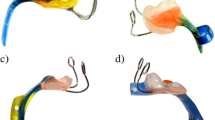Abstract.
Pierre Robin sequence (posterior U-shape cleft palate, glossoptosis, retrognathia) (PRS) is a frequent and heterogeneous neonatal condition of obscure origin. We show here that orodigestive and cardiorespiratory functional disorders are very frequent in PRS and that these functional disorders, as well as anatomical and embryological data, argue for the involvement of brainstem dysfunction in the pathogenesis of some cases of isolated PRS. A total of 66 infants consecutively admitted for isolated PRS were followed-up with observations and investigations focused on their orodigestive and cardiorespiratory disorders. Neonatal clinical examination and neonatal anatomical aspects of the three orofacial features of the sequence were evaluated. Feeding difficulties and respiratory disorders were recorded and infants were classified according to three grades of severity. The relation between functional severity grade and neonatal orofacial features was evaluated, as well as the relation between functional severity grade and specific criteria characterising oesophageal and laryngeal motility and cardiac orthoparasympathetic imbalance. In the first weeks of life, sucking and swallowing disorders (100%), excessive regurgitation (94%), upper airways obstruction (50%), and cardiac vagal overactivity (59%) were noted. Correlation of anatomical features with functional severity grades was poor except for extreme forms of glossoptosis and retrognathia. Specific anomalies of oesophageal motility, pharyngolaryngeal tone and parasympathetic cardiac regulation were described. These anomalies were more frequent in children with the two higher grades of functional severity. Conclusion: infants with Pierre Robin sequence have early and severe anomalies of orodigestive and cardiorespiratory function which do not appear to be related solely to anatomical features and which require proper medical management. We suggest a prenatal and neonatal brainstem dysfunction as a neuroembryological hypothesis to explain the onset of some cases of Pierre Robin sequence.
Similar content being viewed by others
Author information
Authors and Affiliations
Corresponding author
Additional information
Electronic Publication
Rights and permissions
About this article
Cite this article
Abadie, V., Morisseau-Durand, MP., Beyler, C. et al. Brainstem dysfunction: a possible neuroembryological pathogenesis of isolated Pierre Robin sequence. Eur J Pediatr 161, 275–280 (2002). https://doi.org/10.1007/s00431-002-0936-6
Received:
Accepted:
Published:
Issue Date:
DOI: https://doi.org/10.1007/s00431-002-0936-6




